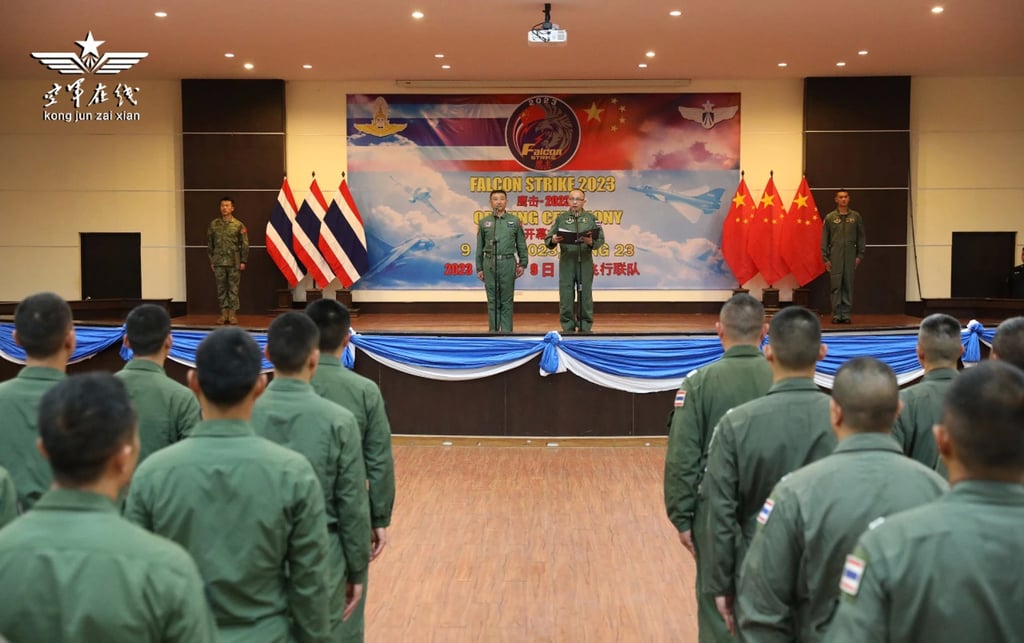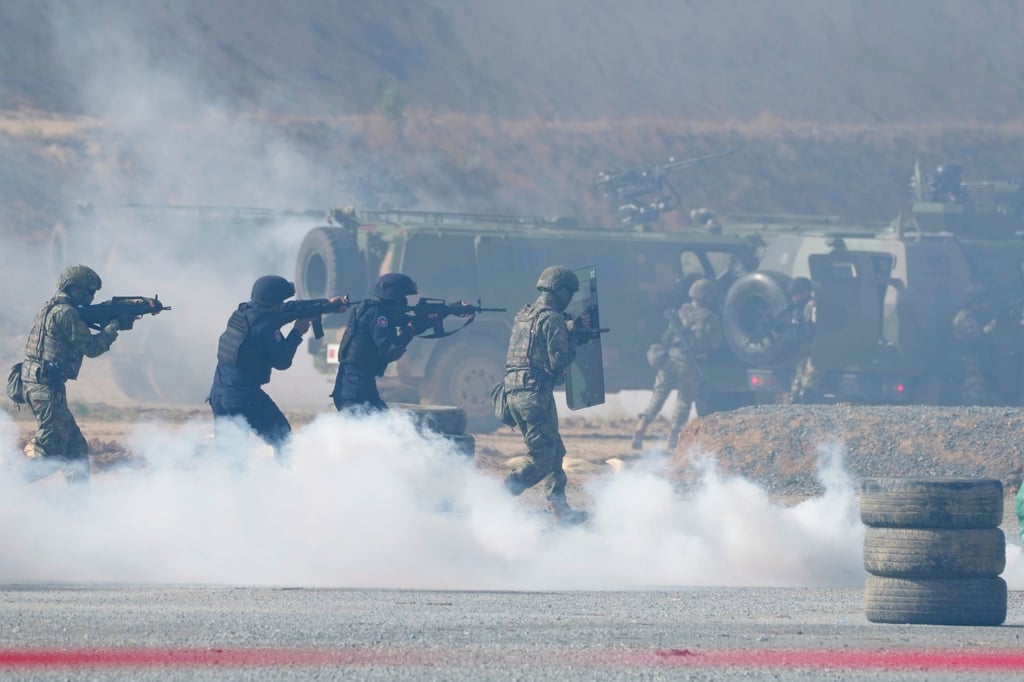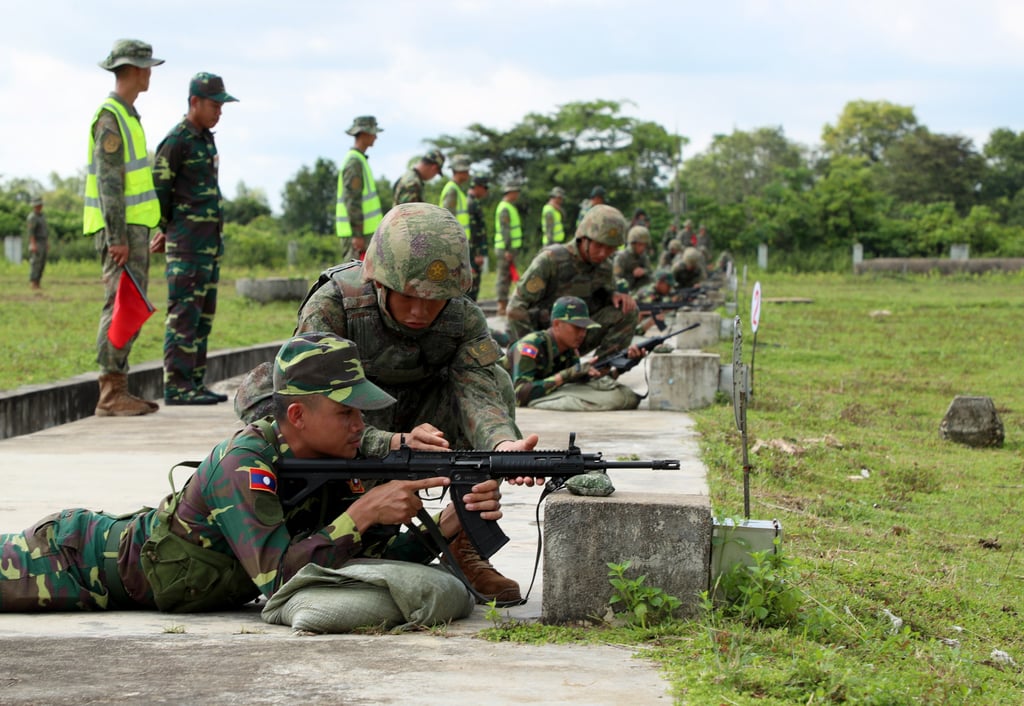As Indonesia hosts a sprawling joint military operation with its neighbours and the West, a quieter yet telling exercise has just concluded between China and Thailand – reflecting a different approach in Beijing’s quest for regional influence.
The annual Super Garuda Shield drills, which kicked off on Monday and will run until September 5, showcase a formidable coalition, with Indonesian troops joined by military counterparts from around the world – including the United States, Australia, Japan, Britain, France, Canada and Singapore.
By contrast, the Falcon Strike 2024 exercises, held from August 18-29, focused more on strategic aims such as cross-border support and joint air defence – essential components, Chinese state media reported, for “a small-scale war”.
Thailand’s involvement in Falcon Strike reveals its cautious stance towards the US, according to Yokie Rahmad Isjchwansyah, a research fellow at the Paramadina Graduate School of Diplomacy in Jakarta, particularly after Washington’s rejection of its bid for F-35 stealth fighter jets last year.
The US reportedly withheld the sale of its advanced F-35s – which are sold only to its closest allies like Australia, Japan, South Korea and Singapore – due to concerns over training and technical requirements.

While Washington engages its military in multilateral drills, such as the Malabar naval exercises with India and Japan, China has concentrated on building bilateral partnerships. Over the past year, it has conducted military exercises with Laos, Cambodia and Singapore, highlighting its intent to strengthen regional ties despite lingering suspicions among some Southeast Asian nations.
Yet China is beginning to adopt elements of the US military playbook by hosting multilateral exercises like the Aman-Youyi – or Peace and Friendship – drills with Cambodia, Laos, Malaysia, Thailand and Vietnam, said Ian Storey, a senior fellow at the Singapore-based ISEAS-Yusof Ishak Institute.
“On the whole, however, China is still more comfortable with simpler bilateral exercises rather than more complex multilateral drills,” Storey said.
The evolving nature of the Thai-China Falcon Strike exercises reflects this trend, becoming increasingly sophisticated yet remaining “primarily performative in nature”, he said.
“It’s inconceivable that their armed forces would fight alongside each other in a regional conflict,” Storey added, underscoring the limitations of their partnership.

Abdul Rahman Yaacob, a research fellow with the Lowy Institute’s Southeast Asia programme, highlights a crucial disparity: the number of multilateral exercises involving China pales in comparison to those conducted by the US, which has maintained a key security role in the region since World War II. This long-standing presence has allowed Washington to forge a vast network of security partnerships that it can leverage for joint exercises.
In recent years, China has expressed a growing interest in expanding its military collaborations with Southeast Asian nations. But Rahman’s insights, drawn from discussions with regional defence officials, reveal a cautious approach among these countries.
“There are some hesitations in regional countries because of their concerns about China’s intentions in the region and its territorial disputes with some Asean states,” he said.
The South China Sea remains a flashpoint, with conflicting claims over islands and maritime boundaries involving China, the Philippines, Malaysia, Indonesia, Vietnam, and Brunei. This contentious backdrop complicates the dynamics of military cooperation.
Most past exercises between China and Southeast Asian nations have focused on non-traditional security areas and were “very basic” in nature, Rahman said.
“Most of these exercises do not lead to combat interoperability,” he said, emphasising that they primarily serve as a form of “defence diplomacy” – allowing Southeast Asian states to enhance their understanding of China while navigating the complexities of regional security.

‘China not comfortable’
Military exercises between the US and its partners are more complex than China’s, with the focus on larger-scale combat operations that enable participating Southeast Asian nations to enhance their defence capabilities.
“China perceives it is the target of these exercises and is not comfortable with them,” Rahman said, citing the “combat nature” of the drills and the fact that the US and China are competing for influence.
“As long as China is still involved in territorial disputes with Southeast Asian states, Beijing’s defence engagement [with the region] … will likely remain shallow and superficial in the long run,” he added.
China organises multilateral exercises to “signal to the US that it cannot be contained militarily”, said analyst Ian Seow Cheng Wei. “For Southeast Asian states, participation in these exercises signals their commitment to fostering closer relations with both powers while avoiding taking sides”.
Beyond combat operations, US multilateral exercises also encompass peacekeeping, humanitarian assistance, and disaster relief, providing countries with valuable opportunities to align their military strategies.
Chinese military exercises, by contrast, typically focus on counterterrorism, counter-piracy, and humanitarian efforts, serving as a platform for Beijing to build trust with its regional neighbours. “By engaging in these cooperative activities, China aims to strengthen regional relationships and mitigate tensions,” said Seow, who is a master’s student in the University of Oxford’s politics and international relations department.

A notable example of this balancing act is the 34 joint patrols China has conducted with Vietnam on counter-piracy and search-and-rescue operations in the Gulf of Tonkin since 2006.
“This cooperation illustrates China’s strategy of using practical engagements to foster trust and collaboration, even amid broader geopolitical conflicts,” Seow said. However, he warned that larger-scale exercises can be perceived as threats, heightening geopolitical tensions.
This year’s Super Garuda Shield involves 5,500 troops, including 2,500 Americans, while Cobra Gold – annual multinational drills hosted by Thailand – sees participation from around 9,000 troops.
China prioritises bilateral exercises due to its cautious approach to information sharing with partners, according to Isjchwansyah, who specialises in researching diplomacy and intermestic relations.
Yet Beijing is actively seeking to increase the frequency of both bilateral and multilateral exercises to counter what it sees as US hegemony in the region.
“China’s success in this regard depends on many factors, such as language barriers and most importantly [its] willingness to be more open to information sharing,” he said.
Such exercises could also act as a platform to showcase China’s offensive military capabilities, and have implications for regional security, Isjchwansyah said – pointing to the deployment of advanced combat aircraft, including Y-20 transport planes and J-10C fighters, during Falcon Strike as evidence.
“This indicates that China is not playing games in holding their military exercises,” he said.


